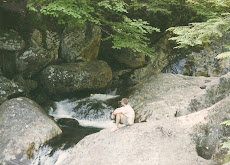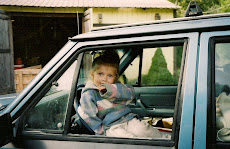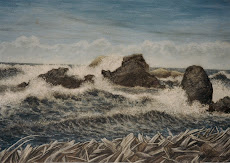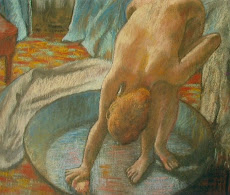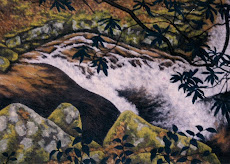Back to the land...
This year we haul out 10 tons of trash from an old burned down home. We plant a large garden, and fruit trees, and build a compost bin specifically for humanure. We build a small pad for a gazebo up under the oaks, and begin building our house/barn, with grading, a stone foundation, a concrete stem wall, and the modified post and beam frame. Everything is done by hand. We also dig four thirty foot swales across the top of the clearing and plant the berms with blueberry. A lot of work, and a lot more to go . . .
I'll also cover the process of picking out a piece of land, the negotiation, and "where to begin?" phase, at least how it all went for us.
[YEAR 2] - We build the shell of a 16'x25' two story cabin from scratch . . . check out how it was built.
[YEAR 3] - We try to finish the cabin . . .
[YEAR 4] - I move up permanently to the property to homestead full-time . . .

Sunday, December 25, 2011
Christmas Day
Still no pictures - I'll try to get some tomorrow morning.
Spent all of Christmas Day under the cabin insulating the addition floor with fiberglass batts. Fun.
Beautiful sunny weather today - nothing like what it should be for December. Looks like a mild winter.
A lot of things to catch up on - let me start with the birds. Have switched them over to an all-natural diet of sprouted grains and lentils which has worked out very successfully. I take a half-gallon of 7 grain scratch, 1 cup oats, 1/2 cup thistle seed and soak it overnight. It swells up tremendously, then is sprouted for 1 day. I add to this a half pound of well-sprouted lentils with good tails. The birds love it and over the course of the day polish off every morsel.
The lentils are there to raise the protein content [soaking and sprouting the grains may raise their protein content a little also, as scratch is only 8%]. Soaking and sprouting dramatically increases the volume of food, it's more digestible, a whole natural food, and there's less waste as the soaked sprouted grains are much larger and not easily scattered.
I screwed in some small metal containers in the coop and filled them with grit and oyster shell. The birds aren't consuming quite as much grit now that the grains are soaked, but they're definitely hitting the oyster shell hard [we ran out of their old eggshells which we'd roasted and ground, as production's so low], and this makes sense as now that they're off layer pellets they need additional calcium.
Since only Rosy's laying there's plenty of room to experiment with diet without affecting production much. Rosy has continued to lay dependably, a guinea is laying now and has 3 eggs in the coop [unrelated to the diet change], and we're pretty sure the ducks have started laying or are at least looking hard for places to lay and flirting with the idea. The guineas and ducks are all mating like crazy as if it's springtime - probably a combination of the light in the coop and the warm sunny weather we're getting.
I'll have to tinker with the poultry diet and see how it goes - but so far I think it's going great. One of the reasons why I think it's feasible at least for here and now is that the birds free-range add day across several acres, there's still plenty of fresh weeds and grass and grubs to dig up with the mild winter, and the grains and lentils soaked and sprouted are just more usable and energizing than the standard factory fare of layer mash/pellets. I'd always wanted to get the birds on a more natural diet but when the birds were laying well I didn't want to mess with it, and we were also concerned with cost. It's maybe an extra buck or two a week to go all natural - but I think it's worth it. And if we're ever able to get the raw ingredients cheap in huge sacks, it may actually end up cheaper than layer pellets.
Garden in the low tunnels is doing well - little warm for the brassicas, cool for the spinach and downright cold for the chard/beets. The mustard greens are doing fabulously though. Lettuce decent - usually the unheaded frilly types and red lettuces seem far more hardy and are doing best in the tunnels.
The loft ladder's been rebuilt at a steep angle against the east wall. The girls' room is finished, almost totally insulated now. We'll have a living room soon where the old kitchen was. Have a large couch and rug so far, and floor lamp. Still need an armchair, rocking chair, and small coffee table. The last bit of insulation that needs to go in is under the main floor of the cabin. The insulation has made a huge difference in heat retention.
I'm picking up Rachael and Brook on Wednesday and they'll be here for 10 days which is exciting. They haven't been up here since July. They'll be a lot of new things for them to see, the ducks, rooster, low tunnels, how far along the interior of the cabin is, the bunny, and the cow.
Remember the jersey/guernsey cross we were going out to look at in Robbins? It's out in a stall in our barn. We brought her home last Sunday.
Her name is Rita, and she's pretty small for a cow, even a dairy cow, at a little over 800 pounds. We paid $800 for her, dropped a hundred on boards for her stall, and another hundred on large animal paraphenalia as well as feed.
This last week of twice a day milkings of our semi-wild cow is a long story which I'll cover in the next post.
.
Saturday, December 24, 2011
Christmas Eve
Brought home what ended up being a rather wild dairy cow a week ago. Very busy trying to gentle her and increase milk production. Will soon have pictures and a full update.
.
Thursday, December 15, 2011
12/15
It's so warm up here for the middle of December we're not even running the stove at night. Thunderstorms are forecast for today.
Putting the insulation in is nearly finished. There are a few pieces to put in in the walls, and all that's left is the floors. We're going to use the same R 19 for the floors because even though the framing's thicker and could accomodate R 30 [2x10 floor joists], the floor heat loss ratio is the same as the walls - 10 to 20%. Only the ceiling is higher at 30%. But with the cathedral ceiling and 2x6 rafters R 19 is all we could fit in the ceiling. Using R 19 for the floors instead of R 30 will save us a little money, it's faced which gives us a vapor barrier, and for a horizontal installation stapling it in place is infinitely preferable to using the metal wands [tiger's teeth] which over time cause the insulation to sag between the wands while it's compressed above the wands.
I've moved the bookcase over to the northeast corner and built a wood box out of scrap lumber for storing firewood inside relatively close to the cool oven side of the stove.
The next step is building the new loft ladder at a steep angle against the east wall. The ladder will be built of 2x6 boards, and will have a handrail along the wall. Since we're moving the ladder to the loft we need to redesign where furniture is upstairs. Right now we're considering sort of making two rooms up here - a bedroom with bed, dressers, toilet area and computer on the west side, divided by the couch with bookshelves behind it so the east side is sort of a library/plant nursery. We'll have to move everything around to see if it works.
On Monday we drove down to visit a friend who invited us to down to learn how to hand-milk her jersey cow for free. It took Rachel and I a while to get the hang of it, but ultimately we were able to milk out a gallon and a half. The lady sent us home with that milk, another gallon she'd milked out the day before, and one of her roosters for our hens - all for free. We're going to go back down on Sunday and take her some home-made bread and try milking her cow again. Until we have our own cow we're going to exchange some work around her farm for milk.
When I first tried the jersey milk once we got home it was still slightly warm - very rich and creamy, seemed like slightly less sweet than store-bought, with a strong dairy flavor. But once it was completely chilled I tried it again and it was just about the best thing I'd ever tasted. We all did blind taste tests between the organic store-bought milk, and the raw jersey milk. For Rachel and I the difference was unmistakable. The 'cooked' store-bought milk is almost undrinkable in comparison to the raw jersey milk. It tasted old, flat - almost like canned milk in comparison. We've been guzzling the jersey milk with every meal, and making raw smoothies with it. Like any raw food, it's high-enzyme, energizing, and digests effortlessly. I've noticed it even makes any meal far more digestible if we drink the milk with it.
Interesting that in the state of Tennessee raw milk is illegal to trade, sell, or even give away. I guess someday they'll make it even illegal to ingest. Just another example, in a long, long list, of how government is there to hurt you, not help you.
We're going up to Robbins, TN today to look at another cow - this one's a jersey/guernsey mix. The only negative thing about her is that she's currently only producing a gallon a day. We'll have to look at the conditions she's in, her pasture, feed, etc., to see if maybe that could be improved. She was bred to a guernsey bull, and is due to calf July 11th, so if we got a heifer out of it that would be awesome, though it's just as likely it'll be a bull, which only sell for a hundred bucks. The heifer would be worth keeping.
We still haven't named the rooster yet. He's a marin/cuckoo mix, with the same black and white barred coloration as Claudia. We started with putting him in the bobcat cage up in the coop. But he kept calling and terrified all the birds in the run which refused to go in and check him out. We then let the rooster out into the run - and he's a big bird, roughly twice the size of Claudia and Rosy . . . and that didn't go so well.
Claudia went straight to the ground desperate for a rooster and all he did was briefly attack her - maybe confused by her coloring and thinking it was one of his fellow sibling roosters he'd always been competing with for hens. Then one of the white male teenage guineas started attacking him, and he flew and pecked back - no injuries, just a short scrap. But we decided to open the coop door and herd everybody out of the run . . . maybe things would go better out of confinement. A fight between one of our guineas and the rooster in the run would have been the end of the guinea . . . but outside if they don't get along the guineas can at least run or fly off and escape.
We were able to get everybody out of the run except the ducks and the rooster. The ducks simply for sheer stupidity - the rooster because he was terrified of the run door and wouldn't go through it [it's a bit of a tight fit for him also]. He's a good 2' tall.
Eventually the ducks found their way out and only the rooster was left in the run. I locked him out there for the night with food and water so there wouldn't be any fighting with guineas over roost space in the coop. I walked up late to check on him and he was hunched up against the run door for bed and looked pitiful - like he really wished he could go in the coop.
The next day we let everybody out and the rooster quickly found his way out of the run and the coop. He spent most of the morning following the ducks around - I guess they were non-threatening, and he'd built some kind of bond while they were all stuck out in the run.
But eventually he started following our hens around, and the next morning he was mating with Claudia and Rosy right outside the front door. Little Bit's a tiny banty and a little too small for him - though we did hear her squawk once where he may have jumped on her. Sometimes the girls like a break from him and go hide under the cabin. He's a little too tall to follow them in there, so instead he stands guard.
He's become a great friendly rooster, following and guarding the hens, eating grain we throw from the front door, and no conflict with the guineas whatsoever. The first night in the coop he followed the girls up and climbed up beside them. With him towering there on the roost, the guineas milled and called and were reluctant to go in the coop and roost beside him. But eventually they did and there were no problems.
The rooster crows quite a bit, especially in the morning. It was really neat the first morning when he was stuck out in the run - there was a heavy fog, the lights were on in the coop, and he was crowing loud and clear through the fog . . . I didn't even hear it till I opened the front door now that the cabin's so sealed up.
The ducks are now herded down to their pens with their nest box as they should start laying soon, if they aren't already [the squirrel could have been stealing a guinea egg]. The drakes are constantly pouncing the females, so they're definitely sexually mature. I have to say raising 3 types of poultry, that the ducks are basically pigs with bills. They eat constantly, and make a huge muddy mess wherever they go, and shit everywhere. And as far as intelligence goes . . . they're on the bottom of the list. They're very entertaining to watch if there's a pool of water around, but otherwise they just don't have the big personalities of chickens. Of course if they start laying well my opinion of them will dramatically improve . . .
Already getting windy and stormy today - 70% chance of rain.
.
Sunday, December 11, 2011
12/11
It's been an incredibly busy week - let me try to summarize it all.
The birds have been out free-ranging with no losses so far. The trap is set out beside the run and I just noticed the other day the bait is missing - something must have run off with it without setting off the trip plate.
The 11 low tunnels we have up are working great. We've had hard frost every night - low to mid-twenties, but the plants are fine. They take a good bit of monitoring though on sunny days to make sure the tunnels are well ventilated. The chenille method allows us to tug up the sides, and the tension on the twine generally holds them in place - though adding a few clothespins to hold up the plastic always helps. No matter how cold and windy it is, if it's sunny the tunnels quickly get up to 80 degrees. And once the sun begins to go down, the temperature in the tunnels plunges fast. Usually they need opened a couple of hours after sunrise, and closed a couple of hours before sunset.
We had our first snowfall last week. The snow covered everything, but there wasn't much accumulation before it started to melt away. By the next day it was mostly gone.
About 3/4ths of the cabin is now insulated. It makes a huge difference in heat retention inside. If Rachel's baking and needs the stove good and hot, the cabin gets so warm especially up in the loft we open a few windows. We have a fan upstairs above the stove we run constantly to blow the hot rising air back down into the kitchen and addition. It actually works pretty well - without it most of the heat just sits up in the loft and downstairs is far cooler.
Only the southeast facing wall and floors still need insulated.
I've built an improved kitchen counter over on the northwest side of the cabin. I put in the large cast iron sink that's been sitting under the building for years - it's not hooked up to running water, but we just bucket in rainwater for wash and drinking, and will put graywater buckets under the sink for drainage. The garden out under low tunnels still hasn't needed any watering yet, so the graywater/duckwater mix for now is going out to the perennials in rotation.
Once the new kitchen's finished, I can move the loft ladder over against the southeast wall at a steep angle with a handrail - more of a stairway. This will be far more convenient than the ladder we have now which is out in the middle by the stove and vertical. Rachel fell from the ladder the other day and her back landed right on the corner of the wood stove - her back hurt for a couple of days and she had quite a bruise but she's okay.
All of the perennials are protected in some way from deer pruning. I ended up stringing fishing line for the large lower blueberries, strung between sapling stakes pounded into the ground every 10 to 20 feet or so. So far it's worked great, though the bottom runs of line I put in to keep the chickens out occasionally rip loose - probably the chickens.
Almost all the caution tape is up around the property - there's only one small section to finish along the road. There's no question it works. We haven't heard or seen any deer since it went up. One of the A frame bird netted setups over the blueberries up at the swales got torn and blown down - I thought maybe a deer had trampled it but after checking it out it was more likely just the wind. It took a only a few minutes to set back up.
We looked at a couple of jersey cows the other day a few miles down the road. One was very gentle and 5 years old but dry and bred just a couple of months ago. The guy doesn't really want to sell them and wants a $1,000 per cow. We're going to keep looking online a while longer till we get the pasture fence up around the lush hillside down from the barn - the pasture is about half an acre and will include some of the creek and woods and will also be used for free-ranging the birds. Rachel found a woman online about an hour from here on a family cow forum who's invited us down Monday morning to learn how to hand-milk . . . this is very generous and helpful as neither of us have ever had a cow though Rachel has milked goats.
There was some interesting mouse drama last Thursday. Rachel and I were out cutting and splitting wood in the front yard. One of the logs was hollow. Once we'd carted up the wood in the wheelbarrow to the front door we kept hearing squeaking sounds while unloading it. We eventually found two baby mice who'd been nesting in one of the hollow logs.
Rachel put them in a small plastic container with bedding inside to keep them warm. They were still blind but had fur - so were about 2 weeks old. We set the container up under one of the lamps to keep them warm.
We went to Gwen's play at the school and stopped on the way home for ingredients for a baby mouse formula Rachel found online. At home Rachel worked with trying to feed them using a dropper - she got them to take a little milk though they were pretty stubborn and resistant. It was amazing how frisky and active they got once warm even though still blind.
I went downstairs and saw a mouse shooting around under the couch, and asked upstairs - "Are the baby mice where they should be?" They were and it was the mother darting around looking for her babies.
So we took the baby mice and set them on the bedding in front of the wood pile. We then all backed off to watch from a distance. The mother kept darting around everywhere looking for her babies. Eventually she went back to the wood pile and found them. She grabbed one and rushed into the hollow log they'd been living in. Then she found the other and took that one in. She grabbed all the bedding and packed it in around them. After an hour or so we took the log and set it in one of our plastic bins with a big piece of insulation, and carried it down outside to where we'd gotten the log from.
Country living . . .
.
Sunday, December 4, 2011
12/4
A spell of beautiful warm fall weather has hit and should last a few days though the rest of it should be rain starting tomorrow.
It turns out the 'wild guineas' are actually owned by a neighbor and they roost in one of his pines at night. So we'll stop trying to catch them. But it's still good they spend so much time here and hopefully they'll interbreed with ours.
We've been extremely busy lately, finishing the low tunnels over the garden [11 total] and insulating the walls of the addition. Every time we put more insulation in we notice a big rise in retained temperature inside. We need to insulate the rest of the cabin before we can start working on siding the barn.
Before the last string of freezing nights we drained the well water out of the hose and overflow tank and shut the well-pump off. Dishes are now done inside with hot water from the wood stove. The garden plants in the tunnels have very little need of watering and the perennials are going dormant so we don't have much need for graywater right now. It's always best to wash out the toilet buckets with the jet from the hose, but for winter we'll just have to rinse them out with buckets of rainwater and air them sufficiently.
I cleaned the coop out and got nearly 3 full wheelbarrows for the compost bin. We'd put in an underlayer of sawdust with a grass/leaf mulch on top, which works very well, but we're down to only 3 bags of sawdust for the toilets so I just did 2 wheelbarrows of grass/leaf clippings for fresh bedding in the coop. I put dried hay in all the nest boxes. Rosy is still laying dependably, but her eggs are about all we're getting. The ducks are definitely sexually mature, but either laying sporadically or the squirrel is stealing them. We've gone back to free-ranging as we were unable to trap the bobcat and he seems to have disappeared for the moment, though the same neighbor who owns the guineas says a bobcat wiped out his chickens.
We did catch Claudia [our barred rock chicken] in the bobcat trap however. We happened to be up at the coop when she wandered in to it and set it off. I guess she'd thought of checking out the chicken bait, but once the trap door shut she just started pacing and complaining till we let her out.
We got a lot of wood cut and split yesterday from small standing dead trees and dead boughs well off the ground. Some of it burns very well, some okay. Rachel started using a creosote remover product to keep down a buildup of creosote in the chimney since we're not burning ideal wood - just whatever we come across that looks dead and reasonably dry. It seems to have helped and the creosote layer in the chimney is only a paper thin film.
A few days ago I put in bird netting over all the blueberry bushes up at the swales [there are 21 plants]. The easiest way to do it ended up being driving a 6' sapling at either end of each bed [there are 5 to 6 shrubs per bed] - which is two saplings for each 30' bed. I predrill a hole for the sapling by pounding in some PVC pipe then remove it. I drive in the sapling at an angle away from the bed so tension doesn't bow it in, then run masonry line or twine between the two saplings and pull it very tight. I cut a small notch towards the top of each sapling so the line doesn't slide up or down. Then I just lay the bird netting over this sort of like an A frame tent. One 15' x 45' piece covers each bed to the ground from the line on either side well - I used one piece per bed. This will not only protect the shrubs from being bitten down by deer [something that's kept them stunted the last few years], but also from our own chickens wandering in and digging up all the mulch and dust-bathing in cavities around the plants, and also any birds trying to steal the berries of course. The last thing I need to do is give them a very thick leaf mulch.
Today we'll get the rest of the caution tape up - it seems to be working and we haven't noticed any deer.
Very windy this morning - usually a sign of a storm on the way.
.
Monday, November 28, 2011
11/28
Very heavy rain the last two days. Schools closed at noon due to flooding, and buses are running tomorrow on a 2 hour delay. Light snowfall is expected tomorrow.
We'll have to finish the low tunnels in the snow tomorrow. And once the weather breaks, we have a lot of wood to cut and split as we're almost out.
Rachel and I drove out to Knoxville today to close on the Sunbright property. After a year-long struggle, we now own it. We celebrated by buying an Ebbing's silverberry, the same shrub all over Atlanta covered in tasty red speckled berries. It's a great permaculture plant and forms a dense hedge. We'll probably plant it on the west/windward side of the garden.
We also bought a car-full of insulation, layer pellets, a squirrel trap, bird netting for the blueberries, and returned the mop bucket.
Over the weekend while walking up to the coop I saw a squirrel running from the chicken run with something white and round tucked up under his chin. I chased him into the woods but he never dropped it and eventually I lost him in the woods. Since none of our chickens lay white eggs, I assumed it must be one of the wooden eggs. But all were accounted for in the coop. So the only conclusion is that the ducks are now laying and he'd stolen a duck egg. I'd have never have believed it without seeing it with my own eyes, but he carried that egg tucked between his chin and chest while bounding across the grass and through the trees. I'll set out the trap tomorrow.
We'll have to use the cellphone temporarily for future photos as the picture-taking button on the camera's broken. Rachel had handed the camera up to me on the top of the ladder, it got caught on her pinkie and went crashing down to the floor. Outside of the picture-button, the camera seems fine. Maybe we can get it repaired.
.
Saturday, November 26, 2011
11/26
Today was a long hard day of putting in low tunnels. Rachel and I got most of them in. There are a couple of stretches of Brassicas that still need covered, and some of the tunnels still need end flaps, but we're close to finished.
Yesterday a large bobcat was terrorizing the birds up at the run. We had let them out earlier to free-range and fraternize with the wild guineas. But one of our guineas launched into the air behind the run, and we spotted a bobcat trotting off into the woods. I caught and carried Rosy and Claudia up to the coop, and we herded our guineas in. Once we had them all penned up, I saw the bobcat running and lunging at them at the front of the run, and went up and ran him off. This cat is much larger than the last one.
I set up the trap last night beside the run with some chicken for bait, and a bed of leaves to conceal the cage floor and trip plate. This morning I walked up to check the trap, didn't see a bobcat in it, but the trap was shut and some of the chicken had been eaten. I assumed the bobcat hadn't gotten in to feed, set off the trap, but was so big it shut on his back and he was able to get out.
So I opened the trap door and was about to reach in to fix the leaves inside. Suddenly I saw an opossum, right in front of me at the edge of the door, and quickly shut the door back up. It was a small opossum, and he just sat there and stared at me. There's always the possibility an opossum has been getting the eggs, and since I already needed to go out to Jamestown for supplies for the low tunnels, I thought I'd go ahead and relocate him.
On the way out to Jamestown the road passes through Big South Fork Area. I pulled in at a picnic site off a large creek to release him. After I opened the door the opossum still just sat there, so I had to tip up the trap higher and higher to get him to slide out. He kept hanging on to the cage floor to keep from falling out, but finally he did slide out and waddled off into the woods. Very cute . . . with a tiny little rat tail.
For the tunnels we're using 4 mil plastic [though I did get some 2.7 I found at Walmart cheap in case we ran short], schedule 40 1/2" plastic electrical conduit for the hoops, and 1/2" rebar to cut into stakes to slip the ends of the hoops down over. I cut 20" stakes and leave about 9 to 10" exposed to anchor the hoops down on. The beds are up to 5' wide and irregular, so each hoop has to be a custom length.
I burned through metal blades for the reciprocating saw in no time cutting the 1/2" rebar. I ended up going to the circular saw with a diamond tip blade with sparks flying everywhere. It nearly melts the ends and i have to pound them smooth so the conduit still fits snugly over it.
I drive in the rebar stakes from 4 to 5' apart at the edges of the beds, slip a keychain over each stake [or modify some other kind of metal loop once we run out of keychains], then put in the 10' lengths of conduit down over the stakes. The height of the hoop at the center we're shooting for is 30", so I just measure the difference, and cut off double the amount from each piece of conduit so it's the right size [think of it this way - taking off 1" from each end of the conduit will cause the top of the hoop to lower 1" - so 2" must be cut off to drop it 1"].
Once all the conduit's in we get out the right size sheet of plastic - 10' wide, and a couple of feet longer than the end hoops of the actual tunnel for overlap. I make a secure connection at the central ends of the plastic so it can be tied down tightly at either end of the tunnel. I find the center end, and roll in a small flat piece of wood and attach it with U nails [I cover the plastic with duct tape on both sides wherever I penetrate it with a fastener]. Once the piece of wood is rolled in snug I drill through the center of it. I knot off a piece of masonry line and feed it through the hole - this is then tied down to a cutoff piece of conduit driven in at a 45 degree angle at either end of the tunnel.
A small sheet of plastic is tucked around the end hoops to serve as an endflap. When it's warm the flap is rolled up and pinned up with clothespins. If weights are necessary to hold down plastic at the tunnel ends or between the hoops to keep it flush with the ground, we use old milk or water jugs with the top cut off full of gravel or rocks pulled from the garden beds. The jugs can be cut so the handle remains and are easily transportable. It's a convenient free alternative to buying sandbags which are a pain to lug around.
We use the chenille method as a way of fully securing the plastic down over the hoops. Twine is threaded through the keychains at the bottom ends of the hoops and run diagonally over the tunnel from hoop base to hoop base. This is far preferable to burying the ends with dirt or laying down sandbags. If the twine is in contact with dirt at the base of the hoops, it's good to go with something synthetic like masonry line rather than jute or cotton so it lasts. We started out using a pack of keychains we picked up at Walmart, but Rachel found tying a keychain clip with masonry line to the stakes right beneath the ends of the hoops works better and it's easier to run the twine through. Just about anything will work.
The chenille is great because it not only secures the plastic nicely down over the hoops, it allows easy access at any time the garden bed by just tugging up the sides - the tension from the twine holds it in place. Though we ventilate this late in the year only at the end flaps, if it were warmer hold sides could be tugged up to keep the bed from overheating.
Wonderful warm weather today, but ahead is 3 days of rain, cold, possible snow showers, and once the rain is over, a week of winter temperatures, every night below freezing. That's why we're in such a rush to get these tunnels in. They should have gone in a month ago, but we've had so much going on.
Today was our second failed attempt at herding the wild guineas into the coop. We can corner them very close to the door, but getting them to wander in is very difficult as they just mill in a panic along the run. Eventually they fly straight into the air to escape. We'll keep trying. Our birds have to stay strictly penned up till we catch the bobcat.
Using only rainwater now for everything - drinking, dishes, laundry. We'd harvested 330 gallons last rainfall. We've only gone through half of it, and rain is coming, so all the barrels will be filled again.
Eating Thanksgiving leftovers the last two days. Probably another week's worth.
.
Thursday, November 24, 2011
The Stock Tank

We got a 110 gallon stock tank from Tractor Supply yesterday. By heating water in stock pots on the stove, plus the hot water in the stove's reservoir, we had a nice long hot bath. And inside . . . we haven't had the luxury of a hot bath inside since February in Atlanta. The tank is made of an insulated material so the water stays warm for a long time - it was still relatively warm in the morning, and it had been a cold night.
It didn't take long to bucket the water out - since it has some soap I distributed it across the front yard.
Thanksgiving was a very busy day for us. I mowed some, mulched bed 9 that has a low tunnel over it which is almost finished - washed 3 loads of laundry - the commerical mop bucket and wringer wasn't any better at wringing out the clothes than the bucket press method we've already been doing - so the mop bucket will have to be returned. I also did the usual chores for the animals and cleaned the bedroom top to bottom.
Rachel worked all day in the kitchen cooking food on the stove. Everything came out great - Rachel thinks food cooked on a stove comes out better than a conventional appliance - the oven retains more moisture, and everything seems more flavorful. We had cranberry sauce, roasted butternut squash, pumpkin, apple, and sweet potato pie, turkey, mashed potatoes and turnips, bread with acorns, rolls, turnip greens, green bean casserole, deviled eggs, and Vic and Jo came by for our Thanksgiving dinner and brought corn salad, wine, stuffing, and a pineapple cheese dish. It was a great meal, and the stove performed wonderfully.
I let the birds out today as the wild guineas were up at the run hanging out with our guineas. It took a while for all the birds to make it outside after I'd opened the coop door [especially the ducks - they didn't figure out how to get out till an hour before dark, though they've used the same run door over a 100 times]. The guineas all seemed to get along well and spent more time together.
Had an egg from Claudia today - cream-colored with dark speckles. Both Rosy and Claudia laid yesterday.
One of the female rouens was walking across the back of another female rouen in the pool today, once I put fresh water in. Either they're confused . . . or it's their way of bullying one another out of the small pool.
We have a tremendous amount of leftovers and don't need to cook for a week.
Heavy fog this morning, but warm and sunny all afternoon.
.
Wednesday, November 23, 2011
11/23
Rain all day yesterday.
Put up more caution tape around the property boundary. I caulked and insulated the windows of the lower story. I started working on shielding the small upper blueberries on the berms. I'm pounding 6" sections of PVC into the ground around each bush, at all four corners, then cutting long saplings to arch over the plant and anchored in the PVC [as I pound it in I take it out and poke out the dirt so there's a good cavity to lodge the ends of the saplings in]. Where the saplings cross above the plant I'll tie them together so there's an even dome over it, then place a piece of bird netting over it and tie it down at the 4 bases of the saplings. The domes are made big enough for next year's growth. It's a long process, with 25 plants to do, but cheap, effective, and practical.
The wild guineas spent most of the afternoon up at the run congregating with our guineas, so we decided to let all our birds out and see how everyone got along now that Bergack has simmered down since his mate Chi Chi's gone. There were lots of fluffed up feathers and bluff charges and angry guinea fighting merry-go-rounds, but once everybody's place on the pecking order was established they all got along quite well. If we could only lure the wild guineas into the coop and shut the door we'd have more guineas and guaranteed good breeding stock. But they're wary about going in the coop, and getting the door shut in time would be difficult considering how skittish they are.
Today we'll get the supplies for the low tunnels and put them in. Rachel's got bread and rolls and 3 pies to bake in the cook stove for Thanksgiving. Last night she was up late shelling acorns to put in the bread.
Watched a great film the other night, Aaron Russo's AMERICA: FREEDOM TO FASCISM. Been reading lots of Dave MacGowan's articles also at Center for an Informed America.
.
Monday, November 21, 2011
11/21
Heavy rain all day today. We had to run out to Oak Ridge for a dental appointment and to get some things from Home Depot - bird netting for the blueberries, insulation, more caution tape, an industrial mop bucket with wringer, caulk, carbon monoxide tester, etc.
After reading several negative reviews about the expensive hand wringers available, we've decided to try the less expensive route of a commercial mop wringer [$35] for wringing out clothes. Some of the hand wringers out there cost up to $200, and according to many people are either incredibly inefficient at wringing out the water, or tear up the clothes.
The last 2 days have spent running caution tape along the property boundary. Originally we were going to just run it around the 4 acre clearing, but following the property line will keep the tape away in the woods and less visible, and help us with ultimately siting a fence line down the boundary. The property was surveyed in 1999, and the corner posts and tree blazes are still present and clearly visible. One upshot to this work, whether it keeps out deer or not, is that we've discovered I was mistaken about the western boundary line of the property. It's much, much further back - we've realized we actually have nearly a third more land than we thought, encompassing the entire ravine area to the west. This will be a good area for goats to clear, and of course another resource for firewood as well as nice buffer to neighbors.
The caution tape so far is strung at 2.5' and 5'. Haven't heard or seen deer in a while. The long stretches of tape bounce constantly in the wind and may wind up an effective deterrent, though of course it's not the most cosmetic approach. Eventually the property line will be strung with 3 runs of unbarbed wire, and I'll weave cut brush and saplings through it to make a sort of wattle fence.
All of the birds spent the night in the coop last night, but tonight the ducks are staying out in the run. Getting an egg every day or two from Rosy still. We actually had to buy eggs today for Thanksgiving - something we haven't done the entire time up here. Next week we'll try a hatchery for increasing the flock.
Tomorrow we'll get rebar and plastic conduit for the low tunnels for the garden, as temperatures will soon be drastically cooling off.
.
Sunday, November 20, 2011
11/20
Nearly 60 degrees this morning. The forecast is for 3 days of thunderstorms with temperatures up into the 70's - barely below 60 at night. Then a long spell of cold. The last couple days have been moderately warm but very windy. Today the air is still.
We worked on fencing and mulching more perennials yesterday. The jujubes, persimmons, bush cherries, and goumis are now done. The little mulberry up by the coop got a tomato cage surrounded in chicken wire. So did the sassafras I'm trying to let grow off the path to the coop [beautiful understory trees with edible leaves]. I've got maybe half the property mowed so far.
The large mulberry and cornelian cherries will become part of the fenced-in cow pasture downhill from the barn - so they don't need protected immediately. All the small perennials down from the barn along the berm made from soil dug up behind the barn - hawthorns, juneberries, currents, a medlar - they didn't do very well last year and will all be transplanted. Either they didn't get enough sun, were too wet, or constantly fighting the tide of blackberry rising behind them . . . they will all be transplanted to what will become the fence line for the pasture from the barn to the oak by the fireplace to the stump by the blueberries. We'll wait till they're all completely dormant to transplant.
All of the blueberries still need protected from deer - fencing would be too expensive. There are about 40 blueberry shrubs. We're going to try throwing bird netting over them. If branches poke through everywhere, or the netting doesn't stay in place, we'll find a way to cage it or stake it down.
We cut and split another round of firewood today up past the upper blueberries. I also cleared some of the saplings and brush in the area where we were working because it was choked with growth. There was a large dead tree fallen a couple of feet off the ground - one end up on a log, the other wedged between a couple of trees. It looked like good wood so I had to figure out a way to bring it down and start cutting it up.
They call it bucking with the chainsaw when you're cutting logs laying horizontally - underbucking is where you cut from below. I made an underbuck cut about 1/4 of the way in, heard the tension break, then from above cut a large wedge with the saw so when the log caved the saw didn't get pinched.
It worked well - just like in framing, where a rafter or joist is in tension on the bottom, and compression along the top, once the area in tension is cut along the bottom of the log, like snipping a cord, it's just a matter of cutting out an area on the upper surface so either ends of the log can fall to the ground. A wedge cut keeps the logs from pinching the saw as they go down.
The garden has had a lot of frost damage from that 20 degree night. But it's still going. Hopefully once the low tunnels are in many plants will recover. I'm going to try bending 1/2" metal conduit for the hoops - I'll use plastic conduit over the bed to get the right size hoop, trace a template of it on OSB, cut this out and lay it on the ground, driving 3/8" rebar stakes every 18" along the arch. The first 2 stakes will have matching stakes 1/2" away from them, so I have a place for the metal conduit to get lodged as I slowly bend it around the rest of the stakes and arch. Though I'd prefer to use 1/2 rebar for the stakes, I don't think it will fit inside the tube of 1/2" conduit.
After a good bit of research on using caution tape to keep out deer, we're going to start with 2 runs of it at 2.5' and 5'. If it appears deer are leaping it, we'll do another run at 7.5'. It's more of a psychological barrier as the tape hums and whips and snaps, than an actual physical barrier. We've got 3,000 feet of tape, we'll see how far that goes.
.
Friday, November 18, 2011
Thursday, November 17, 2011
11/17
Hard frost tonight. We got another sheet of 4 mil plastic today so are able to give an emergency cover to two more beds. We also used sheets for the collards that seem sensitive to a good frost.
We went to Jamestown today for caution tape and materials for the low tunnels. They had a roll of 9 gauge wire cheap and bought it thinking we'd try Coleman's design for low tunnels, with wire hoops instead of conduit. But after getting home and researching it, it doesn't seem that compatible with our broad 5' beds. So we'll go back to Jamestown at some point for conduit and rebar stakes. This will be more durable. Though we've planted right to the edge of the beds, and the arch of the hoops at either end will crowd the plants, we'll harvest from the outside of the beds successively and next year not plant so close to the edge.
I'm using 3' rebar t-stakes for fencing the perennials. Where the plant is big enough to call for 4' fencing, I wire a 4' sapling to the stakes to extend them to the right height - it works for such a light application. The jujubes are now fenced and mulched. I'm now working on the goumis [silverberries] at the front of the house. Next is fuyu persimmons.
Going to get a dozen hens soon as we're down to an egg a day at best. Tonight the guineas and ducks are out in the run refusing to go to bed. I guess something's spooked them again in the coop or they're just stubborn [or stupid]. Tonight will be very cold. I've left the run door open in case they decide at some point to go in. It's nearly impossible to herd them into the coop from the run.
Very cold and windy today. It's good we installed the support brackets for the chimney last week, or this wind may have torn it off. The brackets work great and the chimney's immovable.
After having moved all the barrels to the front of the cabin for the last rain, we now have nearly infinite water for drinking, dishes, and laundry. We've hardly made a dent in the 330 gallons we collected. But I'll do a few loads of laundry tomorrow - I use about 25 gallons a load with a wash and double rinse. Heavy rain is forecast again in a few days. Storing the water long-term was an issue for us over the summer, but now it's so cool and the barrels stay covered so the water keeps well.
Cranes calling and flying high overhead tonight. There was a screech owl calling up near the coop.
Creosote is building up quickly in the chimney with all the subpar wood we've been burning. We got a cresote-remover product today. We'll see how well it works.
.
Wednesday, November 16, 2011
11/16
Heavy rain all day today. I moved all the barrels to the front of the cabin. When the ones below the gutter ends got full, I bucketed it into a barrel beside it. It only took a minute to bucket water from one barrel to another. This strategy got us 330 gallons today. When the siding's up and downspouts attached I can use a small piece of flexible corrugated pipe at the end of the downspout to move from barrel to barrel when one is full.
Cooling off rapidly now that the rain is ending. Another hard freeze forecast for tomorrow night.
We're going to get 'caution tape' tomorrow and run two bands around the clearing to try to keep deer out. There's a lot of evidence it works. We'll put one at a deer's knee-height and one at chest-height. The tape is very cheap - $5 gets you 1000 feet. 6 rolls should do both runs.
I've been working on fencing the perennials. I've tried using saplings for stakes as saplings are free. But they're hard to drive into the ground and want to split all over the place as you pound them in. I'll try sharpening the driving end into a pencil point, and get a metal cap to place on top of the sapling to keep it from splitting apart as it's pounded in. I'll also stick with thicker saplings, a good 1.5" to 2" in diameter.
The cheapest option for long-lasting stakes for something as light-duty as chicken wire is 10 foot lengths of rebar. 3/8ths is $3, 1/2 is $4. Each rod split in half makes two stakes. But I'm trying to keep fencing the perennials a low-cost effort - we've got nearly a hundred young fruiting shrubs and trees, and fencing material is most definitely not free.
Rosy's the only one laying up at the coop. We're getting 1 egg every day or two. We've put the birds back on layer pellets because we found some at the Coop at $10 for a 50# bag and the ingredients aren't that bad. The birds weren't eating the alfalfa, so the protein content of our homemade mix wasn't working. We've found a guy an hour south of Knoxville who has 50# sacks of organic peas and grains - price-wise it will never compare to the 20 cents a pound of layer pellets, but it will be better for the birds and the eggs. We have to get the cash together for a large order because he's 2 1/2 hours away from us.
Once we get the caution tape up and fence a few more perennials [working on the jujubes and fuyu persimmons now], we'll move on to the low tunnels over the garden. It's certainly getting cold enough soon to need them - temp tomorrow . . . 49/30.
.
Monday, November 14, 2011
November

The garden heavily mulched. Eventually we'll mulch and plant the interior perimeter.

The juneberries fenced and mulched. Eventually all the young fruiting perennials will get this treatment to keep deer and birds and chickens out. We'll lay cheap bird netting over the top.

The fig tree. This needs heavily protected from winter cold.

The growing wood pile in the barn. We spent a few hours yesterday cutting and splitting dead wood at the front of the property for the next cold spell. The wood seasons so well here on the south-facing side of the barn protected from rain - I think eventually we'll attach lean-to sheds on either side of the driveway for wood season and storage.
Very windy yesterday but warm. We can occasionally hear the chimney creaking in its support box socket. Hopefully the extended support brackets come today as it's forecast to be just as windy today [right now though it's rather still and sprinkling].
Birds are doing okay locked up. Going in to roost in the evening no problem. I take them up a bucket of weeds from the garden every morning and throw it into the run. Not only do they get some stimulation and nutrition here, the weeds will ultimately help to build the soil of the run so it rebounds faster after they've trodden it down when locked up.
Didn't even need to run the stove yesterday, it's been so warm.
Just noticed all the potted pepper plants on the table behind the computer are full of red ripening mini-peppers. It was an experiment to see how viable were the seeds in a bag of mini-sweet peppers we bought at the grocery store. So far they've done very well. They get water with the same duckwater/graywater fertigation mix as the garden.
.
Sunday, November 13, 2011
11/13
A warm cloudy night in the 50's. Windy. Winds today should hit 30 mph. Our chimney support brackets haven't arrived yet but I think the chimney will be okay as long as there are no gusts.
We have a couple days of rain starting on Tuesday. We'll get two more rain barrels tomorrow to set up beside the others at the front of the house. Till we put in downspouts I'll just bucket the rain from the full barrels to the empty so each rain brings us 220 gallons.
We also need to get a smoke alarm and carbon monoxide tester. We've felt a little sleepy with the stove going all day and windows shut and we need to make sure it's not carbon monoxide.
Yesterday was a long day of mowing. I mowed around the lower blueberries and the lush hillside which will soon become the pasture for the Jersey cow. I got over 10 wheelbarrows of mulch. I finished heavily mulching the garden, and piled up the rest in front of the compost bin for cover material. I also fenced around the juneberry beside the bin with chicken wire, and heavily mulched it with grass clippings. It should produce well next year.
Only 1 egg yesterday, Rosy laid. Something must have startled the birds in the coop because they stayed out in the run and refused to go in and roost for bed. Only the banty Little Bit was up on the roost. Rachel was able to call in the other chickens with corn - Rosy and Claudia. But we could not get either the ducks or guineas to go in even with banging on the run with crutches and long branches. Rachel tried crawling into the run to shoo them inside, and the guineas just went berserk - 'popcorning' everywhere [when they try to fly and bounce of the chicken wire ceiling we call it 'popcorning']. Rachel kneeled down and held her head concerned they'd fly into her face. We had to give up and let the ducks and guineas spend the night in the run with the run door open. Sometimes it feels like we have the dumbest birds . . .
I tried to dig up a couple of grounding rods that stuck up in the yard as one caught the mower. But they're in too deep - I had to cut them low with the reciprocating saw.
I put up the pool and tarp beneath it into the barn. The pad under the pool is like concrete from all the compression of 4,500 gallons of water.
We're starting to get low on wood so today we'll cut and split a bunch more from the front of the property. There are huge piles of seasoned trees and branches laying in a maze that will make good firewood.
Rachel made banana pancakes yesterday with sprouted wheat berries on the stove - very good. We finished off the potato soup for dinner, and played 'Guesstures' with the kids [a type of charades].
The compost bin is slowly falling apart from all the weight and moisture. Next time a chamber's empty it will have to be rebuilt on the inside with some durable nontoxic material. Synthetic decking would be ideal, but it's $20 a board.
.
Friday, November 11, 2011
11/11
27 degrees last night. Everything that was covered did fine. A patch of mature chard that only had a thin sheet of plastic over it was a little wilty. The broccoli and cauliflower that was left uncovered also got a little wilty.
Last night a few guineas roosted in the oak over the coop. I thought I'd counted 3 out of the coop, but it was actually 4. Rachel and I stood out on the doorstep about 10 at night and saw 2 guineas suddenly take flight way across the property to land high in other trees. This usually means a predator. I hurried up with the flashlight to see if it might be a racoon or something but there was nothing, no animal, no dead bird. But I only spotted 2 guineas in the other trees with the flashlight. I then recounted the guineas inside the coop and realized 4 were out.
The next morning I noticed only 3 guineas up outside the coop. So we lost another bird. The only conclusion I could come to was that a great horned owl took one. If it were an animal in the tree I would have either spotted it or found the remains of the guinea. Whatever took it took it from the air and disappeared with it - only a great horned owl is probably capable of that. I looked it up online and apparently many people have had their entire flock of guineas wiped out by great horned owls.
It took hours for the frost to clear from the grass. We watched AMERICA'S WAR ON DRUGS while we waited for it to warm up. I replaced the blades on the mower and mowed for hours. It's the final mow of the entire property before I won't be able to mow again till spring - we need the cover material. I was able to get about 10 wheelbarrows of shredded leaves and grass clippings out of the front yard. 1 wheelbarrow went to the coop over the sawdust, and the rest went out to the garden beds - some areas needed a heavier mulch, the big brassicas needed mulched close around, and the large areas where tomatoes and peppers were pulled needed remulched. I got about half the garden mulched so far. Once it's finished the rest of the clippings will be piled up for cover material for the compost bin. It won't last all winter though. We need to score some cheap old rotten rolls of hay.
While going down the driveway with the wheelbarrow I spotted a large cat right in front of me, trotting down the driveway. At first it looked like a large gray feral cat - then I noticed the lack of tail. Another bobcat. It went off into the briars but not in any particular hurry. These bobcats are bold - middle of the day, out hunting right under my nose. It may be just the season though, when predators get a little more desperate for food.
I walked back to the house to see if Rachel could keep an eye out outside while I kept mowing as I was down by the road and all the birds were out - but I'd had to wake her from a nap and she was slowly waking up. About 20 minutes into mowing I heard the birds hollering and knew somebody'd been killed. All the birds were together and looking around and Goldie was missing. We just put up the birds this evening and Goldie is definitely gone. She'd been an excellent layer.
We were able to herd all the guineas into the coop tonight - I shooed 2 off the roof with a crutch and we got them in. This is good because all the birds need locked up again while we try to trap and relocate yet another bobcat.
Tonight we'll have frost again so the fig and garden is covered. Rachel spent much of the day wrestling with the stove to improve its draft. She says it's better now.
The mower is still really shaky and clunky-sounding. Something is loose somewhere and out of balance but I can't find out what's wrong with it - we may just have to bite the bullet and take it to a dealer for them to take a look at it.
.
Thursday, November 10, 2011
Hard Frost
A hard frost is expected tonight. We jugged out the small vulnerable plants, those too big for a jug went under plastic or in plastic bags, and beds 8 and 9 got covered in a large sheet of 4 mil plastic - this will be used for the low tunnels over these beds once we get the frames constructed.
The fig tree is in the background covered in a pink comforter. I used three stakes and chicken wire to make a broad cylinder around it, filled it with 11 large bags of leaves, and covered the upper shoots with buds poking up from the leaves with straw and an upside-down bucket. This keeps the blanket from bending and crushing the upper shoots and buds. The bucket and blanket will be used only on very cold nights, till winter really hits - then we'll cover the whole thing with a tarp and tie it down.
I put up old sheets of plastic over the coop windows to keep the draft out of the coop. Plexiglass would be ideal, but it's very expensive. The west window which really brings in the cold and wind is covered with rigid 1/2" insulation. Once we get a glass cutter we'll start cutting whatever glass we need from storm doors at the thrift store.
Today was cold and gusty and we ran the stove all day. I did two loads of laundry with the breather washer, washed dishes, fertigated the garden, and we disassembled the pool and drained the water in the bottom, hosed it off and laid it out to dry. It cleaned pretty easily. We'll pack it up before the next rain.
Big salad from the garden today, and arugala is growing like a weed - coming up in cracks in the concrete like dandelion. We also had eggs and toast cooked on top of the stove . . . somehow more flavorful, like cooking over a campfire [maybe the slow-cook in cast iron].
The two mixed runner drakes were mounting the crippled rouen today. This rouen has a terrible wobble to her walk and constantly shoots her head down and to the side like a nervous tic. She has all the colors of the male but no drake feather, so we weren't sure of her sex. Either the drakes are confused or have figured it out. She may be now sexually mature and start laying. That would be nice since we're averaging only 2 to 3 eggs a day. We could never breed her with her disabilities, but eating the eggs'll be fine.
We're catching deer out on the property every night, probably biting down fruiting perennials. We need to get them all protected with chicken wire. A neighbor suggested surrounding the forest line with two strips of 'caution' tape - apparently it works for hunters trying to funnel deer into a certain area. May be a cheap solution if it works.
Last night I heard a noise out by the dishes and took a flashlight to investigate. It was Rosy pecking at a pot. I guess she got suprised by the dark and decided to roost in the dishes. I carried her up to the coop and found the ducks all nestling down on the hillside. I herded them in. It's partly the birds getting confused by the early dark outside and late light inside the coop, and also I've been shutting the front door to the coop and leaving the new run door open to encourage the birds to use it as a way in and out. It takes birds eons to learn a new routine. The ducks have yet to figure it out.
3 of the 12 guineas are roosting in the oak over the coop tonight. At least the other 9 have sense enough to seek shelter for a long cold windy night.
.
Wednesday, November 9, 2011
11/9
A hard frost is expected tomorrow night. We'll have to cover 2 beds in plastic again, jug out the lettuce and chard, and heavily mulch the fig tree.
We couldn't get the oven in the cook stove hot enough to bake. Rachel read over the manual, and yesterday took the panel off the oven side of the stove to clean out ash over the oven. There was a huge buildup of ash on top of it interfering with the draft. We cleaned that out, and sealed every joint in the stove pipe with fireproof caulk. It looks like it's worked, because the oven is already at 350 degrees.
The next thing on the list for increasing the efficiency on the stove is to replace the firebox door gasket. The fireproof rope can be bought in a roll at the hardware store.
We ordered the extended roof brackets to help support the chimney as it has some play in it. It's possible a good gust could tear it off. They say no additional support for a chimney under 5' is necessary if using a support box - but the chimney shouldn't be able to wobble like that. It's locked tight into its socket in the bottom of the support box, but the sheet metal at the bottom of the box is not that heavy gauge and is allowing the chimney to move.
A hawk perched on the run yesterday, and all the guineas hollered at it. All of our birds right now are too big to be bothered by a hawk. It eventually flew off.
4 eggs yesterday. Everybody laid. 2 today - Goldie and Claudia.
Light rain on and off today and cloudy skies. Will be much cooler tomorrow.
We got the insulation finished in the addition ceiling this morning, and cleaned the kitchen. The girls' room is much warmer.
.
Monday, November 7, 2011
11/7
So warm today we've got to open the windows while running the cook stove. We could go back to appliances, but the wood is free and everywhere, electricity isn't.
We watched Zeitgeist today, and had a long day of caulking and insulating the ceiling of the addition. The caulking and 4 rolls are done - we have 2 more rolls to put in.
I was up late last night researching how to evenly distribute heat throughout a home with a wood stove. The first thing is to seal up the building well and insulate [though of course not airtight], the next thing is ceiling fans in the cathedral ceilings to mix heat around. Structural changes if possible like removing transoms. And if necessary room-to-room fans installed in the walls to move heat from one room to another. We could install 2 in the lower wall of the loft to blow hot air into the addition. They're about $50/$60 a piece.
Tomorrow we're going to Knoxville for Harley's dental appointment, will catch a bath here and catch up on chores through the afternoon, then in the evening there's a meeting at the school for Harley's Beta Club. It'll be a busy day and we'll keep the birds locked up till we get back from Knoxville. We'll let the ducks out though and put them in the pen - they make an absolute mess in the coop sloshing water and drilling.
Beautiful full moon and Jupiter is bright in the eastern sky.
.
Sunday, November 6, 2011
11/6 Night
A warm beautiful fall day today. The next two days are forecast to be even warmer. Rain and cooler weather starting Wednesday.
We got up about 2 AM last night and put wood in the stove. When we woke around 7 or so the fire was out as we'd only filled it half way with the small wood we had laying around. We started a new fire and the cabin warmed quickly. Rachel made oatmeal on the top of it. This evening she's going to try sourdough biscuits in the oven.
We'd intended on keeping the birds locked up a full week to give the predator a chance to move on, but while letting out the ducks through the front door [they're reluctant to go out the new run door as birds hate anything new] two guineas flew out over her head. So after keeping the hens up long enough to lay we let everybody out. No mishaps. Rosy came into the house to eat barley from our hands. She'll jump up into the air to get it if you hold a grain in the air and it's funny to watch. 2 eggs today.
We fired up the new 18" Homelite chainsaw today and spent a few hours cutting and splitting dead wood for the stove. It took a while to get the saw adjusted to the right idle speed and chain tension, but once we did it cut through everything very easily and we piled up nearly half a rick. Rachel and I worked together which makes chainsaw use safer, as well as more efficient, as she can move small logs along a prop for each cut and all I do is cut. Most of the pieces split easily [especially when struck right] with the 6# splitting maul. We do need a good stump to split on - the 2x12 board got split to pieces, and splitting on the ground is not very efficient and too low for a good precise whack.
Vic and Jo stopped by to see the new stove installed. We had a salad from the garden for lunch - lettuce and radishes with grated cheese and hard-boiled eggs and homemade blue cheese dressing.
Tomorrow we're insulating the ceiling of the girls' room so their room will better retain heat - it's the coolest room in the house. If that doesn't solve the problem, we'll install a series of wall vents in the lower loft wall which we share with the upper wall of the girls' room. This will help air better circulate through the cabin, instead of heat coming up from the stove and getting trapped in the loft.
.
11/6
WE HAVE HEAT!
We worked all day yesterday to get the chimney and wood cook stove installed. There was heavy fog up until 11:00 AM, so we had to wait till then for the metal roof to dry to get out on it.
For the roof cut-out, I marked it from below and drilled out the corners so it could be marked from above. I then cut out the metal with tin snips, the roofing felt with a utility knife, and the sheathing with a circular saw. The tin snips left a very jagged uneven cut, and took nearly a half hour to do. If I had to do it over again, I'd use a circular saw with either a demolition or diamond-tipped blade to cut through the entire roof from above. I'd also cut the square out a little bigger than necessary to we wouldn't have to wrestle with the support box to get it into position.
The support box was not that difficult to install perfectly level, and was mounted to a box framed around it using headers and mini-sections of rafter to support where I'd cut out a rafter to center the chimney.
The 5' chimney locked into place reasonably plumb, but has a wobble to it as the bottom of the support box is not a very heavy-gauge sheet metal. Installation guidelines say only a chimney over 5' needs supported with brackets to the roof - but the chimney has such a wobble we worry a good gust would tear it off so we'll have to order the support brackets [another $100].
The rubber boot gasket was not fun to put in. We cut it so it slid tightly down over the chimney so there would be a good seal. But because of the angle of the chimney versus the roof, the 17" boot hardly covered the 13" roof hole for the support box. And when we sealed it down with polyurethane and rubber-gasketed metal screws every inch or two around the perimeter after molding it to the ribbed roof, the boot pulled the chimney out of plumb. Next time for sure we'd order a larger boot. But the boot itself has some manufacturing errors. For one the flat base of the boot should extend longer on the down slope side like conventional flashing. The other is that though the gasket part of the boot is labelled for where to cut according to your chimney diameter, it should also have marked how to cut for the chimney-roof angle. An oval cut would keep the boot-gasket from pulling the chimney out of plumb. If we'd cut a little deeper on the up-slope side the chimney would not have been pulled up-slope.
Anyway we got it in and also got covered in sticky polyurethane [supposedly longer-lasting than silicone]. We also sealed the top of the boot against the chimney with a fireproof Metacaulk - a red non-toxic putty, than when moistened with spit smooths out nicely. The chimney cap just took a moment to lock on to the top of the chimney. The support brackets with not only support the chimney but pull it back to exactly plumb [it's not really visibly out of plumb from below, so it's not that bad].
The girls gathered firewood, I positioned the sheet of Durock we got from Vic and screwed it to the floor marking the exact stove position so the flue outlet-chimney position would be exactly plumb. We'd researched all kinds of different insulated hearth ideas till we talked to a retailer who dealt mostly in these types of cook stoves. He said it doesn't get hot underneath the stove at all - his cat sleeps under it. He had a balloon at a party get stuck under it and it didn't even pop. So we opted for a temporary sheet of 1/2" Durock and 4 tiles 1/4" thick to get the right stove height [the entire lower story when it is floored will have some type of tile].
Putting the pipe together didn't take long, the gaps in the oval flue outlet were caulked with Metacaulk which requires no curing time so we immediately fired up the stove. It works like a dream. No smoke, the cook surface got very hot very fast, the water in the reservoir started heating up, and the loft part of the cabin went up to 75 degrees [35 outside]. The girls room did not get nearly that hot though as heat rises from the stove and tends to get trapped in the loft.
We're going to try several ways of fixing this. First we're going to insulate their ceiling to hold the heat they do get in. Keep the french doors wide open to see if over time their room gets warm. If this doesn't work we'll install vents in the lower loft wall that we share with the girls' room. This way heat can move through here to them. Ultimately the entire wall needs removed between the main part of the cabin and the addition, which of course would help tremendously. We'll take it one step at a time.
Rachel got the stove going this morning. A light frost outside, and already sixties inside. Very nice. The stove burns the wood very efficiently - nothing like a campfire.
Today we're going to straighten up the kitchen after yesterday's construction, stockpile wood in a corner of the cabin, cut more, and start insulating the ceiling of the girls' room.
.
Saturday, November 5, 2011
Wild Guineas

The wild guinea family hung around most of the day. Above is a picture of them up at the coop. I had to zoom in all the way from the cabin - otherwise they might have run off.
The parents are a dark slate gray, the three immatures are a much lighter gray. We've seen them on and off all year.
This was the first time they were bold enough to come all the way up to the coop to snack on spilled grain. Bergak [the white male we brought with us from Atlanta] has fought on several occasions with the wild guinea male and driven him off. But now that his mate Chi Chi is gone [taken by the bobcat], he's mellowed some. Our birds have been locked up for a couple of days due to predation so this was an opportunity for the wild guineas to come closer.
We're down to 12 guineas now. The males fluffed themselves up at the approach of the wild male, who ran a few times at the run in a little guinea charge. The females stuck in the run meanwhile called desperately for him.
We wish we could get the wild ones to join our flock. But Bergak may continue to drive the male off. If only we could get our young and their young to interbreed we'd have a much bigger future flock and some genetic diversity. Our 11 immatures are all from the same parents - Chi Chi and Bergak.
These wild guineas abandoned Brian and Leslie's homestead [where we got the ducks] about 2 miles up the road and have been hanging around here ever since.
Yesterday we ran a few errands and I started on the roof - removing a section of rafter to put the support box and chimney through. I started the cuts with a circular saw, then jigsaw, then camp saw, and finally hand saw to finish as I ran out of room up against the roof sheathing. Nothing quite like cutting wood upside down by hand in a tight space while standing 12' up on top of a shaky ladder. Today I'm waiting for the metal roof to dry so I can get out on it and cut through it to install the chimney. It may be a while. Right now we're socked in with heavy fog.
The ducks, I guess from watching the guineas so much, are constantly trying to fly. They run around on tiptoe beating their wings. Occasionally they'll get a few feet off the ground. When we went to put them up for the evening yesterday one of the female rouens was standing up on top of the nest box.
Three eggs yesterday, from Claudia, Rosy, and Goldie. Little Bit almost never lays so for the chickens we have left it was 3 for 3, a good egg day. It's interesting how egg production always seems to rise when the birds are locked up. The only conclusion is that when free-ranging they don't necessarily lay where they're supposed to.
The 4' piece of HeatFab stovepipe should be delivered today, and Vic has a sheet of cement board and 4 tiles for the stove to temporarily be positioned on so we can get the right connection height. If all goes well, we could possibly get the stove installed and fired up this evening.
But the fog needs to burn off before we can get started.
.
Friday, November 4, 2011
11/4
Rain all day yesterday. Much cooler.
The UPS guy delivered the rubber boot flashing two nights ago. Rachel explained exactly where to turn around, but in the morning we saw he'd run over the artichokes. One mature plant and two seedlings were killed. We let UPS know. The driver returned yesterday to look at the damage and was apologetic. He said he'd prefer to pay for replacing the plants out of pocket than file an accident report which would go on his record. We tried to calculate the price of replacing the plants online with shipping and came up with $40. We let the driver know. He was abject at the cost, but said he'd bring the money by early next week. We feel bad for him, but at the same time, these guys need to fix the damage they do when they rush these deliveries. I'd had a sumac run over by a dumptruck delivering gravel a few years ago in the exact same spot. The spot is cursed. We'll have to fence it off. So much for next year's artichokes. After dying off over the summer they'd recovered nicely with cooler weather and heavy fertilization [full buckets of straight duckwater].
We set the stove in position yesterday and marked it on the floor. We dropped a plumb bob from the ceiling to mark exactly where the support box and chimney needs to go. I also put in a few braces to support the rafter temporarily that must be cut in order to center the chimney in the cabin.
I organized the tools in the shed yesterday, and built another run door on the coop, the south side, that leads to outside instead of into the run. This way in the morning we have an easy way to release the ducks while keeping the other birds in. We may eventually use this door as the only entry to the coop for the birds once they go back to free-ranging, and leave the front door shut.
I think we'll wait and install the chimney tomorrow. Today would have to be rushed. We've got to take a trip to Wartburg for silicone, screws, get caught up on cleaning, dishes, and fertigation after yesterday's rain, and have a get-together dinner at Vic's tonight at 5:30 with a few neighbors.
No eggs yesterday. I went to check for eggs a little before noon yesterday and found Rosy pecking and eating the blue egg Goldie had laid. This is very bad chicken behavior - Rosy has always been a pig, maybe she's not getting enough protein, it might be because Goldie laid in the duck box on the floor and an egg on the ground is more vulnerable to being eaten. Maybe Rosy has been doing this kind of thing for a while and that explains the missing eggs when we know the girls are laying. The bottom line is the last of our donated chickens are doing next to nothing productivity-wise . . . we soon need to get a whole flock together of birds we want to raise and breed. Probably Welsummers.
The ducks have not yet started to lay and are about 5 to 6 months old now. The two mixed runners have gotten their upcurled drake feather - so they're obviously not laying. We think the bobcat got the only girl. The mixed rouen drake still has major neurological problems, with a crippled walk and a nervous tic that makes him constantly throw his head down and to the side. The four female mixed rouens are filling out more like meat birds than layers but we'll see what happens. All the ducks are sort of 'rescue' birds we got for free from a nearby homesteader who's moving soon. It's more been for the experience and learning than anything else. When we start raising ducks in earnest it will probably be Harlequins or Khaki Cambells - good layers.
.
Thursday, November 3, 2011
11/3
Very sunny and warm yesterday, 71 degrees - a beautiful fall day.
All 5 windows on the west side of the cabin are now insulated and boarded up. There was a 1/2 off sale on lamps at the Habitat and we picked up 2 floor lamps and a table lamp for under $20. We also found a lot of cheap white cotton material for facing the insulated curtains. Rachel will start on that once she's finished the wool gloves she's knitting me.
The chickens and guineas were locked up all day to keep them safe. Claudia laid a strangely-shaped pale egg. She might have just started laying again - or has been laying elsewhere for quite some time. Rosy also laid.
We herded the ducks down to their pen at the north end of the garden and put back up their orange mesh fencing with step-in posts. Herding them out of the coop in the morning is a production. Today I'll install another run door on the coop for easy release of them without going in and stressing all the birds trying to herd them out the front door without any chickens or guineas escaping.
Our rubber chimney flashing boot came yesterday evening. All we need now is silicone caulk to install the chimney. Rain is forecast for today, so we'll cut the hole in the roof and put in the chimney tomorrow.
We drove over to visit some neighbors whose yard I mowed. They want me to start mowing on a monthly basis beginning in the spring. There's a tree they need taken down also - but it's tall, leaning, rotten, and beside a power pole . . . it would have to be winched down rather than cut - a risky, labor-intensive process.
Rachel made sourdough biscuits last night. The first batch that went directly into the oven after cut-out turned out perfect. The ones allowed to sit for a bit turned out almost like rolls. It's amazing how fast the sourdough starts acting on the dough.
It's windy this morning, building up to rain. Rachel drove down to the bus stop to meet the driver to pick up a 25# sack of whole wheat. The bus driver's a Mormon and had picked up an extra bag for us since she knew we were interested in finding sacks of whole wheat berries. The cost was a little over $12. We ultimately want to get a good manual grain mill for grinding our own flour for bread. They're around $300.
.
Wednesday, November 2, 2011
11/2
35 degrees outside this morning, and 50 inside. The insulation has made a huge difference.
Yesterday I insulated and boarded up 2 more windows on the west side. I cleaned out the stovepipe sections that came with the stove with a 7" chimney brush. We're still waiting on one last section of 4' HeatFab stovepipe from Selkirk. The rubber boot flashing for the roof should come today. Thursday when it rains we'll need to get 2 sheets of cement board to put under the stove and high-temp silicone caulk.
We lost another guinea yesterday. We heard the chickens and guineas hollering. I looked out the window and saw three of our chickens in front of the house looking up towards the coop. There was a chicken squawking up the hillside out of sight. I wondered if it could be Buffy. I saw the guineas panicked and scattered up by the coop. I hurried outside.
The squawking was coming from Little Bit up behind the shed. Up at the coop I found a pile of guinea feathers beside one of the white oaks. Guineas were slowly flying down from the trees. They usually only take to the trees when something really scares them.
I spotted a couple of small guinea feathers at the edge of the woods behind the coop. Rachel and I followed the trail of feathers through the woods. Eventually it led to the kill site. There was a great pile of feathers and fresh blood. We followed the trail of feathers from there but eventually lost it and never found either the killer or the guinea.
We think it's a coyote. A bobcat would have abandoned the kill with us coming after him. It also could have never completely ripped the guinea apart that fast. It had to be something big enough to make a fast thorough kill, able to flee through the woods with it in its mouth, and wolf it down almost completely even though we were after it. We hear plenty of coyotes around here, but never seemed to have any predation from them for some inexplicable reason. While wandering the woods beyond the coop we also encountered two old remains of guinea kills.
Well it's clear now what happened to Buffy. Maybe she wandered off to the woods to set and got eaten. Then the predator decided to get bold and go after more birds. That's 2 in 4 days, which means something that will stick around for easy meals.
We tried to herd all the guineas into the coop at evening but most took to the oak over the coop. The birds must be locked up in the coop and run for at least a week. If anything bothers them in the run we'll set out the trap. Today we'll have to find a way to herd the rest of the guineas into the coop while temporarily locking the other birds out in the run.
The ducks must be let out though. They make way too big a mess in the coop with water and drilling. Usually I go in and herd them out the door while Rachel quickly opens and shuts it so no other birds can get out. It works but is a lot of stress for them. What I need to do is install another run door that leads to outside. The ducks would be the first ones out then we could simply shut the door.
We'll set back up the ducks' pen with orange mesh fencing by the garden. This particular predator is sticking to the woods, so the ducks should be fine down in the open not far from the cabin.
Eventually we'll fence the entire perimeter of the property and this should alleviate some predation. We've thought of raising Pyrenees dogs with the chickens to protect them, but they're large dogs requiring a costly upkeep and only a large flock with good egg sales would offset it. We're not there yet. We've haven't even got enough eggs for ourselves.
It's always discouraging to lose another bird. But this is sort of inevitable with free-ranging.
.
Tuesday, November 1, 2011
More Garden Pics
These pics of the garden are from 2 to 3 weeks ago as I had such a hard time loading them to Blogger.
Here is the compost bin. We're filling the left chamber now. The center chamber will be ready to use next spring, and the right chamber will be ready next fall. The bin itself is now 4 years old and falling apart. I wish I could think of some non-degradable nontoxic material to rebuild it with:

Lettuce, Brussel sprouts, and what was left of the tomatoes after devasted by blister beetles and frost. The tomatoes have since been removed:

A patch of luxurious turnips. Some are now ready to pick:

Mustard greens. Have always been mild for us throughout the year, though rather holey from flea beetles in the spring:

Chard. Once established, very durable and able to be picked over and over. Wonderful raw in a salad, and one of the best boiled greens with a little salt, pepper and butter. A perfect winter greenhouse plant. Hit hard and almost totally defoliated by blister beetles in late summer, but rebounded well. Doesn't like much frost though:
 Cherry belle radishes. Have done very well for us here. Got very spicy when big over early summer. But this time of year, mild even when huge. The yellow frisbee marks where I am in my fertigation rotation:
Cherry belle radishes. Have done very well for us here. Got very spicy when big over early summer. But this time of year, mild even when huge. The yellow frisbee marks where I am in my fertigation rotation: Brassicas, with peppers in the background before dead and removed. The Brassicas are much larger now and growing fast with almost no predation from bugs. They get heavy fertigation with a deep grass mulch:
Brassicas, with peppers in the background before dead and removed. The Brassicas are much larger now and growing fast with almost no predation from bugs. They get heavy fertigation with a deep grass mulch: The plant stakes are made from cut-up Venetian blinds and labelled with permanent marker:
The plant stakes are made from cut-up Venetian blinds and labelled with permanent marker: More Brassicas, mostly broccoli and cauliflower. One of the broccoli's is now heading up nicely, about 3-4 inches across, very dark:
More Brassicas, mostly broccoli and cauliflower. One of the broccoli's is now heading up nicely, about 3-4 inches across, very dark: The last of the highly productive peppers before removed after the killing frosts:
The last of the highly productive peppers before removed after the killing frosts: Lettuce, with some young chard and kale behind them. Lettuce has grown fabulously for us here, never a blemish on it and very mild. We fought it going to seed in early summer due to the heat, but this time of year it fills out nicely. It's astonishing what perfect lettuce we can grow here in the midst of so many destructive bugs - they never touch it:
Lettuce, with some young chard and kale behind them. Lettuce has grown fabulously for us here, never a blemish on it and very mild. We fought it going to seed in early summer due to the heat, but this time of year it fills out nicely. It's astonishing what perfect lettuce we can grow here in the midst of so many destructive bugs - they never touch it: Beds 8 and 9, the summer beans and corn beds. Now full of seedlings. Will be covered in low tunnels soon. Everything is planted in deep furrows between high mulch rows. This allows water retention during the typically dry fall, and shelter out of the wind. There are red and golden beets, spinach, turnips, mustard greens, lettuce, etc:
Beds 8 and 9, the summer beans and corn beds. Now full of seedlings. Will be covered in low tunnels soon. Everything is planted in deep furrows between high mulch rows. This allows water retention during the typically dry fall, and shelter out of the wind. There are red and golden beets, spinach, turnips, mustard greens, lettuce, etc: .
.
Blog Index
BUYING RAW LAND
11/8/08
TRASH CLEANUP
11/10/08
WINTER IN ATLANTA
11/12/08
SPRING IN TENNESSEE
11/14/08
STARTING A GARDEN
11/15/08
BUILDING THE COMPOST BIN
11/15/08
THE FROST
11/16/08
GRADING THE BARN
11/18/08
DIGGING SWALES
11/19/08
PLANTING FRUIT TREES
11/19/08
BUILDING A STONE FOUNDATION
11/20/08
THE CONCRETE STEM WALL
11/21/08
BUILDING A SMALL 12'x12' PAD
11/21/08
THE GARDEN
11/22/08
BUILDING A DRIVEWAY
11/23/08
INSTALLING THE SILL PLATES
11/23/08
THE MODIFIED POST AND BEAM FRAME
11/27/08
FRUIT IN THE GARDEN
11/28/08
THE BARN FRAME
11/29/08
AUGUST IN TENNESSEE
11/30/08
HANGING THE JOISTS
11/30/08
CLEARING THE LAND
11/30/08
COUNTRY NEIGHBORS
11/30/08
THE HARVEST
12/1/08
PLANS FOR A CABIN
12/14/08
THE LAND IN WINTER
12/22/08
BARN UPDATE
12/29/08
WINTER PLANTING
1/4/09
EDIBLE PLANTS
1/10/09
WINTER TREES
1/12/09
WINTER TREES II
1/21/09
CHATTAHOOCHEE RIVER
2/11/09
THE STRAW BALE CABIN
3/26/09
THE STRAW BALE CABIN II
4/2/09
1880 FARMHOUSE
5/6/09
HOMESTEADING / THE CABIN
8/13/09
THE POST AND BEAM CABIN
8/22/09
RETURN TO TENNESSEE
8/25/09
SITE WORK
8/30/09
DIGGING THE FOOTERS
9/4/09
THE PIER FOUNDATION
9/10/09
911
9/11/09
FINISHING THE PIER FOUNDATION
9/12/09
THE GIRDERS
9/13/09
FRAMING THE FLOOR
9/16/09
DECKING THE FLOOR
9/17/09
THE POST AND BEAM FRAME
9/19/09
THE RAFTERS
9/20/09
INSTALLING THE METAL ROOF
9/21/09
FRAMING THE WALLS
9/26/09
DOORS AND WINDOWS
9/27/09
TENNESSEE IN JULY - OUR LAST MONTH
10/2/09
TENNESSEE IN OCTOBER
10/10/09
THE BARN FLOOR
10/15/09
PIGEON MOUNTAIN
11/10/09
NOVEMBER
11/16/09
PERMACULTURE: ANOTHER ROUND OF FRUITING SHRUBS
11/22/09
DRIFTERS
11/30/09
THE BARN ROOF BEGINS
12/20/09
'DRIFTERS' PART I
12/30/09
WEATHER
1/1/10
NEW YEAR'S IN TENNESSEE
1/25/10
DRIFTERS: PART II
3/2/10
MY SISTER'S WEDDING
3/21/10
FERTILIZING WITH HUMANURE
3/28/10
THE ADDITION FLOOR
4/19/10
THE ADDITION
5/11/10
RUNAWAY
6/13/10
FINISHING THE ADDITION
.........................The Timeline.........................
1992
-MAY . . . for Patty and I's first date, we skip school and go to the Pinnacle - a wooded overlook off the Susquehanna River.
-SEPTEMBER . . . I leave our hometown of Lancaster, PA for college - Penn State in Reading, 45 minutes away.
1993
-FEBRUARY . . . Patty and I both drop out of school, and camp in some woods behind a grocery store in Lancaster.
-MARCH . . . Patty steals her mother's credit card, and with it we take a train to Utah. We ultimately end up on the Northwest Coast, living in Port Orford, Oregon.
-APRIL - OCTOBER . . . We join a traveling carnival and work in it for 6 months. We sleep in the back of a Ryder truck, and go through California, Idaho, Washington and Oregon. I run the guns, and Patty does the goldfish. We save $9,000.
-NOVEMBER . . . We return to Lancaster and are arrested for stealing the credit card.
1995
-OCTOBER . . . We bike from Lancaster down to Charleston, South Carolina. Patty wrecks in North Carolina, and a friend drives us the rest of the way. We live in Charleston for 2 weeks.
1996
-JULY . . . Our first daughter June is born in Lancaster, PA.
1997
-MARCH . . . We sell everything in our apartment, and hike out of Lancaster with backpacks and our 9 month old daughter. We reach the Susquehanna River.
-APRIL - JUNE . . . We get a canoe and paddle 500 miles up the Susquehanna River to its source. We camp on islands. We get a ride to the Erie Barge Canal and paddle west.
-JULY . . . We are arrested in Little Falls, NY. Our daughter is taken, we're charged with neglect, and we fight the courts for months. We are cleared of all charges, but never get her back.
-SEPTEMBER . . . We take a bus out to Ruidoso, NM and camp in woods just out of town. We return to Lancaster and camp in the Brickyard for the rest of the month.
-OCTOBER - FEBRUARY . . . We live in an apartment in the Amish community of Strasburg, PA. Amish go by in their horse and buggies every day.
1998
-FEBRUARY . . . Our second daughter Rachael is born. We try to deliver her on our own at home and fail. Patty ends up in the hospital with a c-section.
-MARCH . . . We get a ride from a friend down to Covington, Virginia. We stay a week, and look for places to camp in the surrounding national forest. We find nothing, and go to New Mexico.
-MARCH - MAY . . . We camp in the Gila National Forest, north of Pinos Altos, a mile from the nearest trail. We camp above a spring with an infinite view west. We start building a hogan.
-JUNE - SEPTEMBER . . . We live downtown in Santa Fe, NM. Patty markets her paintings, and I get a N.Y. literary agent for my first book 'Flesh Aflame'.
-OCTOBER - DECEMBER . . . We rent a house in Crescent City, California, on the Northwest Coast, a mile from the ocean, on the edge of a bird sanctuary. It's great until the rains begin and we run out of money.
1999
-JANUARY - FEBRUARY . . . We camp in the Uwharrie mountains of central North Carolina, and look for a place to build a winter home.
-MARCH . . . We get a canoe and paddle the Holston River down towards Knoxville, Tennessee.
-APRIL . . . We get dropped off in the Smokies and paddle Fontana Lake. We stash our canoe at Chambers Creek and hike in to the Smokies for a secret camp. Patty paints the creek, and we stay 3 weeks.
-MAY . . . We live in a trailer just off the ocean in Myrtle Beach, SC. The sky is beautiful after storms and we love the pelicans.
-JUNE . . . We camp in the Brickyard back in Lancaster, PA, saving money for an apartment.
-JULY - DECEMBER . . . We live in Lancaster and save for our trip back out to New Mexico. We also buy the jeep.
2000
-JANUARY - JUNE . . . We camp and travel all over the Southwest, from the Gila, to Organ Pipe, to the Weminuche in Colorado. Brooke is born in February in a motel in Deming, NM.
-JULY . . . We stay in condos with a friend in Aspen, Colorado. I do concrete work. We then go to California, and look for a place to live in the Russian River area.
-AUGUST - OCTOBER . . . We rent a small house in Tesuque, NM, just outside of Santa Fe. We hike up into the Pecos Wilderness. We become vegetarians.
-NOVEMBER . . . We visit a friend in Tucson, AZ, then drive to Crescent City and the Northwest Coast. The beautiful weather is over, and the rains have begun. We don't stay long.
-DECEMBER . . . We return to Pennsylvania, and live out of our car in the Philidelphia area while Patty works at a restaurant. We sleep in parking lots and rest stops. It's the coldest December on record for the area, with the wind chill it's -10.
2001
-JANUARY . . . We head south for warmth, try the Chatooga area of South Carolina, then camp in the woods of northern Florida.
-FEBRUARY - JUNE . . . We live in Asheville, NC, in the middle of the Southern Appalachains. We spend nearly every day out on the trails, hiking, and learning plants.
-JULY . . . We get mountain bikes for touring, and bike the Blue Ridge Parkway to the Smokies.
-AUGUST . . . We camp in the Weminuche Wilderness of southwest Colorado, and do a 6 day fast.
-SEPTEMBER . . . We stay in Loveland, Colorado with a friend. We climb Long's Peak on the day after 9/11. We then drive to Vermont, and look for a place to live in the Burlington area.
-OCTOBER - DECEMBER . . . We rent a house in Tucson, AZ, and try to become raw fooders.
2002
-JANUARY . . . We hike in to Jordan Hot Springs in the Gila.
-FEBRUARY . . . We bike in to Turkey Creek Hot Springs. We stash our bikes near the mouth of the creek, and hike the rest of the way. Many of the pools have been ruined from floods.
-MARCH . . . We go to Vermont again, this time the Bennington area of southern Vermont. It's way too cold.
-APRIL - JULY . . . We rent a house in Asheville, NC again. This time we have a large garden, and become 100% raw fooders. Every day I'm out hiking the trails gathering wild edible plants.
-AUGUST . . . We cash out all our credit cards, and move up to Shining Rocks Wilderness in the Southern Appalachians, camping at over 5,000 feet. There are blueberry fields everywhere, and blackberry, and wild cherries. Not only are we mono-raw fooders now, much of our food is wild. I hike barefoot everywhere. We bathe in the pool below the falls.
-SEPTEMBER . . . We visit a friend in Atlanta, and on a night full of alcohol I break my foot in 3 places. I'm told I'll be crippled with arthritis, and ultimately never walk again.
-OCTOBER - DECEMBER . . . We rent a furnished condo in Tucson, AZ. I cut my cast off prematurely with tin snips.
2003
-JANUARY . . . We camp off the Gila River at Box Canyon, just up from the city of Gila. I'm still on crutches. We meet Jabber-Mike, and Vet-Mike, and Doug. We trade juniper berries for Doug's black walnuts. We're still 100% raw fooders, and Doug teaches me the local plants.
-FEBRUARY - MARCH . . . We return to Atlanta for free medical care so I can learn how to walk again. PT is hell.
-APRIL - MAY . . . We go back to the Gila and camp off the Gila River. We gather cattail, nettle, primrose flowers, and harvest prickly pear pads. We find the most perfect hot spring in all of the Gila, man-made, at Brock Canyon.
-JUNE . . . We fall off our raw food diet, and camp up at Black Balsam again off the Shining Rock Wilderness. We gather wild strawberries. We then camp above the Amicalola Falls in north Georgia for 2 weeks. We become committed to the idea of buying land.
-JULY - SEPTEMBER . . . We live in Woodstock, GA, just north of Atlanta. I do a 14 day water fast.
-OCTOBER . . . We paddle Fontana Lake in the Smokies, on our way to Nova Scotia. We find a great camp and gather wild persimmons, but ultimately abandon the trip.
-NOVEMBER . . . We go back to camping off the Gila River at Brock Canyon. I begin 'June'. We run totally out of money, and gather and clean 10lbs of desert willow seed to sell to a local guy in Gila. He gives us $20/lb, and we use the money to get back to Georgia.
2004
-JANUARY . . . We go to north Florida, and check out the sinks, and the aquifer springs, and paddle the Wacissa River.
-FEBRUARY . . . We paddle the Suwanee River in North Florida. Patty makes a basket out of greenbriar.
-MARCH . . . We camp in the pine flats of Apalachicola National Forest. We make baskets from grapevine, cordage from the retting of Spanish Moss, and a mat from palmetto. We camp here for 3 weeks with no money while we wait for our tax refund. We're 100% raw fooders again.
-APRIL . . . We camp off Owl Creek and paddle the river. There are free hot showers in a nearby campground. There's a great trail with wild blueberry, and we gather the new shoots of bracken. We later camp in Tate's Hell.
-MAY . . . We camp at Sand Creek in the Ocala National Forest, an hour east of Atlanta. I gather cattail in the Beaver Pond. I edit and type up the 'June' book at a nearby library for a literary agent.
-JUNE . . . We drive out to Oregon and camp off the Illinois River in the Siskiyous.
-JULY . . . We camp in the Adirondacks off Jones Pond.
-AUGUST . . . We camp in the Jemez Region of northern New Mexico. We gather wild mushrooms, and sell lobster mushrooms to chefs in Sante Fe. We camp at San Antonio Hot Springs for a week, and Big Tesuque Campground outside Sante Fe.
-SEPTEMBER . . . We go back to the Gila and camp at Brock Canyon. We gather desert willow seed again. We swim and play games in the river. We see tarantulas. I gather prickly pear fruit in baskets we've made from willow. We take a trip up to Turkey Creek Hot Springs.
-OCTOBER . . . We camp in the Oconee National Forest southeast of Atlanta, under persimmon trees in a field. We also camp up on Pigeon Mountain near Rocktown.
-NOVEMBER - JANUARY . . . We live in Atlanta.
2005
-FEBRUARY - MARCH . . . We move to Portland Oregon. We paddle the Wilamette River, and go to the nude beach at Sauvie Island, just after Mt. St. Helens erupted.
-APRIL . . . We return to north Florida looking for land to buy. Everywhere is flooded, and there's been a lot of damage from the previous hurricane.
-MAY . . . We camp up on Pigeon Mtn. The weather's perfect, and there's more wild food here than anywhere else.
-JUNE . . . We go to Arizona, and camp in the Hannigan area of Apache National Forest. We ultimately try to get back out to Oregon, but car problems make it not possible.
-JULY . . . We return to Pigeon Mtn in Georgia. The blackberries are in.
-AUGUST . . . We stay in a campground off the ocean in Jacksonville, Florida, while we look for jobs and a place to live.
-SEPTEMBER . . . We move back to Atlanta.
-OCTOBER . . . We abandon the jeep with 320,000 miles in a motel parking lot.
2006
-MARCH . . . the girls and I camp up at Pigeon Mtn, in a secret camp we've made.
-JUNE . . . the girls and I go back to Pigeon and camp longer, this time starting a wigwam from red maple saplings, muscadine vines, and grass I collect naked in the field with a small knife.
-AUGUST . . . the girls and I camp up at Graveyard Fields off the Blue Ridge Parkway. Every day we gather the wild blueberries and swim in the pool beneath the falls. We hike all the trails, and establish a secret camp in a grove of juneberries.
2007
-FEBRUARY . . . We look at property in north Florida.
-MARCH . . . We look at property in Asheville, NC.
-JUNE . . . We look at the 10 acres in Sunbright, and make an offer.
-AUGUST . . . We close on the Sunbright property, and take the kids to Disneyworld.
-OCTOBER . . . The girls and I camp up on the property in Sunbright, and clean up the trash from the fire. I build a fireplace out of old concrete blocks.
2008
-APRIL - SEPTEMBER . . . The girls and I camp up on the property. We clean out the rest of the trash, build a compost bin for humanure, plant the garden, and fruit trees, I dig the swales, do the stone foundation for the barn, and the stem wall, and the post and beam frame. We build a pad for the gazebo.
2009
-APRIL - JULY . . . The girls and I camp up on the property again. We build the 2 story cabin from scratch, plant another garden, and more fruiting trees and shrubs.
-OCTOBER . . . I put the upper story floor in the barn.
-NOVEMBER . . . The girls and I begin building the barn roof.











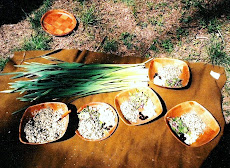









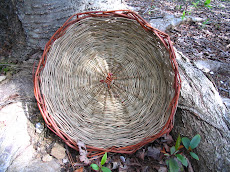







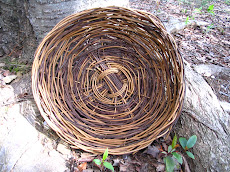

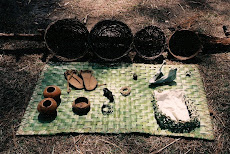


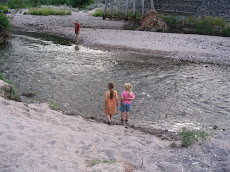

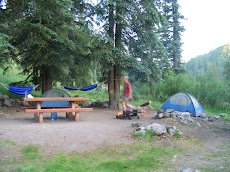


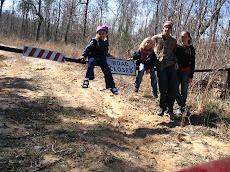






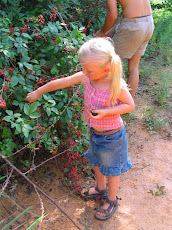







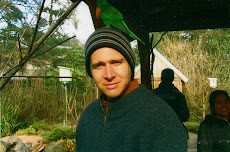
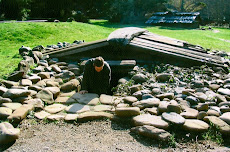

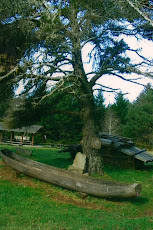



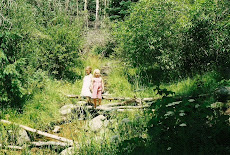
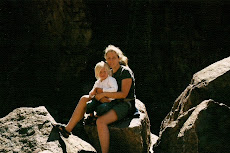
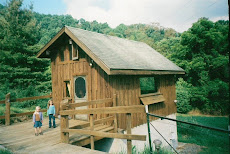

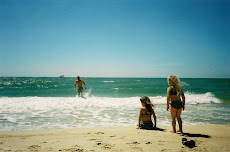
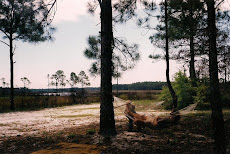

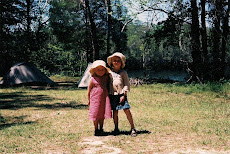.jpg)

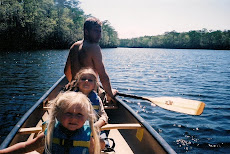.jpg)

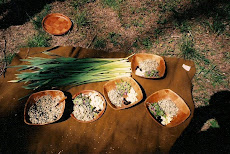
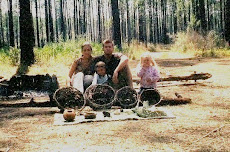
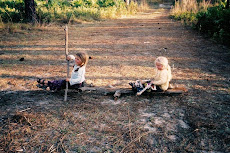.jpg)



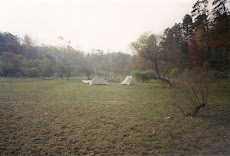

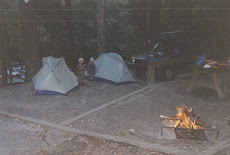


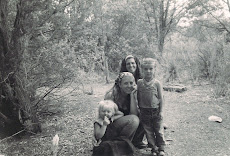.jpg)
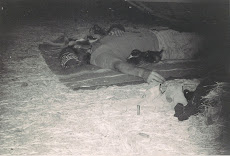.jpg)
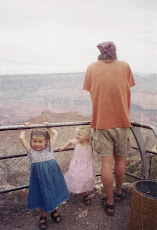
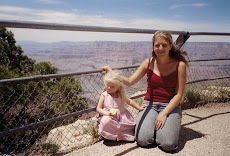.jpg)
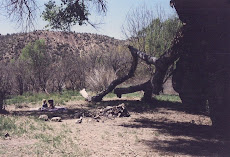.jpg)
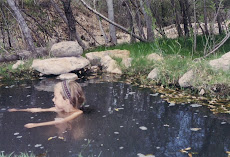
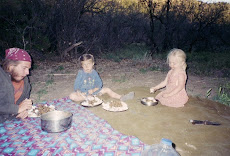.jpg)
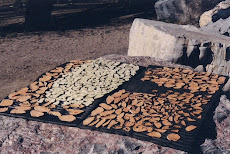
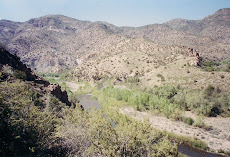.jpg)


